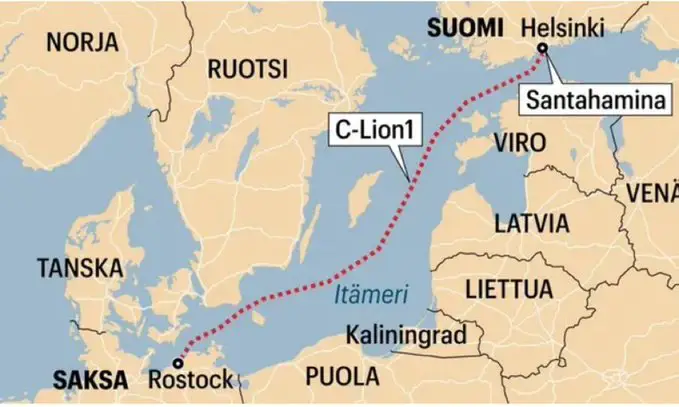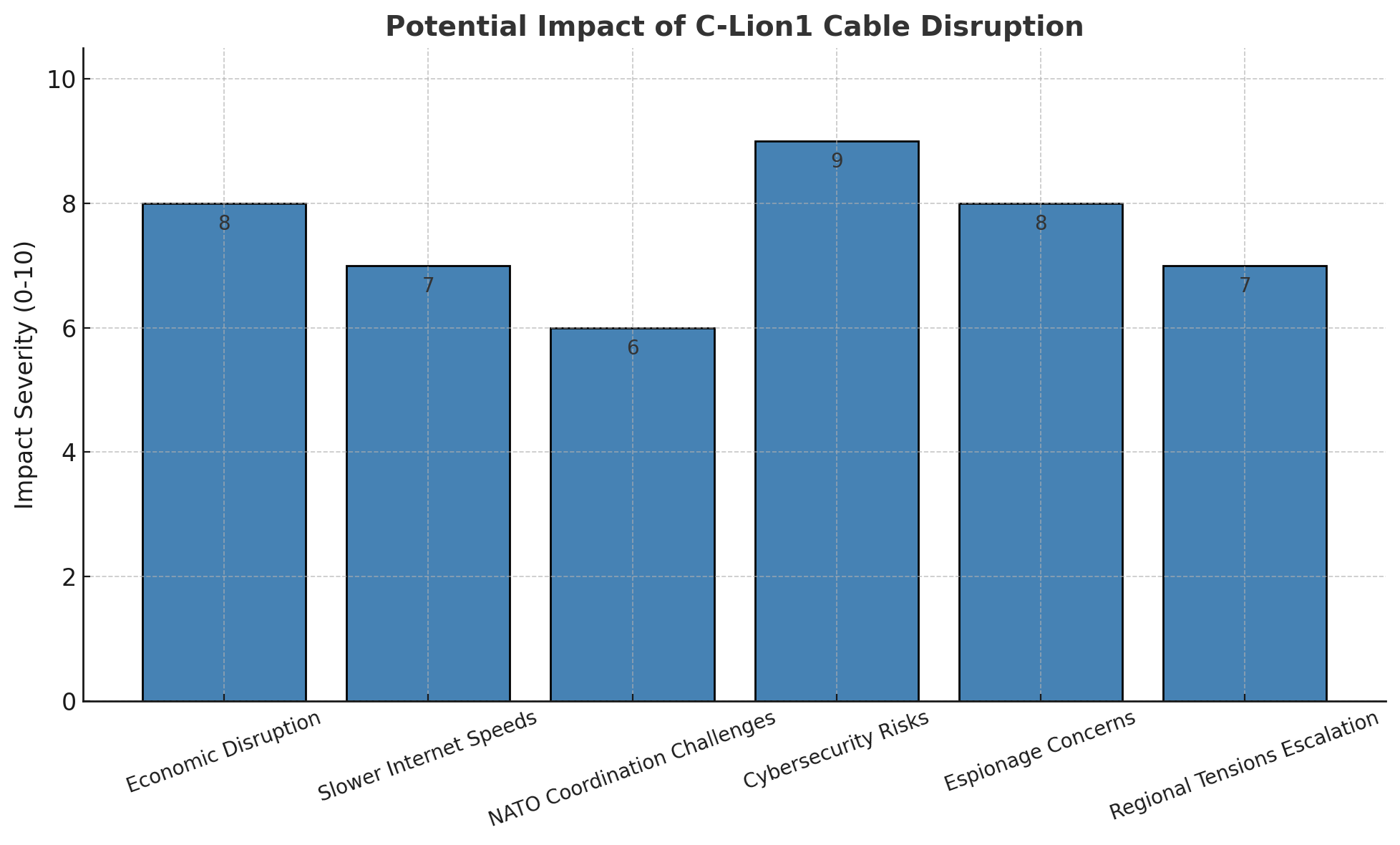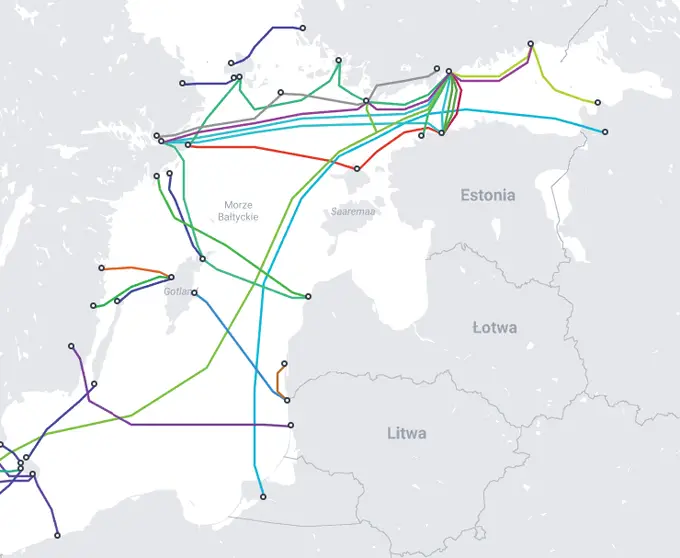On November 18, 2024, Finland’s direct lifeline to Central Europe—a critical submarine cable known as C-Lion1—was mysteriously severed. This 1,173-kilometer-long fiber-optic cable, boasting an impressive 144 terabits-per-second capacity, served as a digital backbone for high-speed internet, facilitating trade, communication, and strategic exchanges between Finland and Germany.
Now, with the cable offline and investigations underway, the Baltic Sea is under global scrutiny.
The disruption raises concerns over the vulnerability of critical undersea infrastructure and the broader implications for security in a region already fraught with geopolitical tensions.
The incident isn’t just a technical hiccup; it is a stark reminder of the fragility of modern digital connectivity in an era of heightened global competition and conflict.
The C-Lion1 Cable: A Vital Artery in a Digital World
Since its commissioning in 2016, the C-Lion1 cable has played a pivotal role in strengthening Finland’s position as a digital hub in Northern Europe. Its direct connection to Germany has reduced latency for data transfers, bolstered economic activity, and supported a range of industries reliant on seamless connectivity. Financial transactions, cloud computing, streaming services, and industrial communications depend on such infrastructure.
In economic terms, the cable acts as an enabler for Finland’s integration into Central Europe’s data economy. Beyond its commercial value, the cable also carries implications for national security, particularly as Finland integrates more closely with NATO and aligns with Western defense strategies.

How Do Submarine Cables Break?
Submarine cables are generally robust, but they are not immune to damage. The shallow waters of the Baltic Sea—averaging just 55 meters in depth—make cables particularly susceptible to interference. Initial assessments of the C-Lion1 break have prompted speculation across four primary theories:
- Fishing Trawlers:
Fishing activities remain a leading cause of submarine cable damage globally. Nets dragged along the seabed can easily snag on cables, causing tension and eventually leading to breaks when the gear is hauled up. - Anchoring Ships:
Misplaced anchors from vessels can drag across the seabed, slicing or damaging cables. Given the Baltic Sea’s heavy maritime traffic and its shallow depth, even minor navigational errors can have outsized consequences. - Natural Phenomena:
Though less common, underwater landslides, earthquakes, or even unusually strong currents have been known to displace or damage cables. However, the Baltic’s calm seabed makes this explanation less likely in the C-Lion1 case. - Sabotage:
The most concerning possibility is deliberate interference. The Baltic Sea is a hotspot for military and espionage activities, particularly since the Russia-Ukraine war intensified regional tensions. The C-Lion1 cable’s proximity to the controversial Nord Stream pipelines raises questions about potential strategic targeting.
While accidental causes like fishing or anchoring remain the most plausible explanations, the geopolitical context makes sabotage a theory that cannot be ruled out.
Baltic Sea: A Theater of Geopolitical Contest
The Baltic Sea has increasingly become a focal point of great-power rivalry, with undersea infrastructure playing a central role. Submarine cables, which form the backbone of global internet and communications systems, have quietly emerged as strategic assets. Unlike terrestrial networks, these cables are largely unprotected and remain vulnerable to both accidental damage and targeted attacks.
Recent history underscores this vulnerability:
- Nord Stream Incidents (2022): The destruction of sections of the Nord Stream gas pipelines, which run parallel to some key submarine cables, has intensified concerns over undersea infrastructure security. While the perpetrators remain unidentified, the incident highlighted the ease with which critical systems in the Baltic can be disrupted.
- Military Maneuvers: NATO and Russian forces have conducted an increasing number of naval exercises in the Baltic. These operations, often involving submarines, further complicate the security landscape.
In this tense environment, even accidental disruptions risk being misinterpreted as hostile actions, heightening the potential for escalation.
Economic and Strategic Fallout
The C-Lion1 outage highlights the cascading effects of submarine cable disruptions. Economically, Finland’s connectivity to Central Europe is critical for industries ranging from fintech to telecommunications. Although redundancy in global networks often mitigates the immediate impact of such incidents, the loss of a primary high-speed link can result in slower data transfers, reduced reliability, and economic inefficiencies.
On the strategic front, the disruption comes at a critical juncture for Finland:
- NATO Integration:
As a newly inducted member of NATO, Finland’s security and resilience are under heightened scrutiny. Reliable communication channels are vital for military coordination and information sharing within the alliance. - Cybersecurity Concerns:
Submarine cables are not just physical assets but also cyber vulnerabilities. The potential for espionage or data interception further complicates the security calculus. - Energy and Data Convergence:
The proximity of the C-Lion1 route to the Nord Stream pipelines exemplifies the overlapping nature of energy and digital infrastructure. Any attack or disruption risks spilling over into other sectors, amplifying the consequences.
Mitigating the Risks: Lessons for the Baltic and Beyond
The C-Lion1 incident underscores the need for greater resilience and security for undersea cables, particularly in high-risk regions like the Baltic Sea. Several steps can be taken to address these vulnerabilities:
- Enhanced Monitoring and Surveillance:
Deploying specialized sensors and surveillance systems along critical cable routes can help detect and deter potential threats. Technologies like autonomous underwater drones could play a key role in this effort. - Coordination Among Allies:
NATO and EU nations must collaborate to protect shared infrastructure. Joint naval patrols, intelligence sharing, and coordinated responses to disruptions will be essential. - Legal and Regulatory Measures:
Clear guidelines for maritime activities near submarine cables, including stricter controls on fishing and anchoring, can reduce the risk of accidental damage. - Redundancy and Diversification:
Investing in alternative routes and backup systems can minimize the impact of individual cable failures. Finland, for instance, may consider additional connections to Sweden, Estonia, or Denmark to enhance network resilience.

A Wake-Up Call
The C-Lion1 disruption is a microcosm of the challenges facing critical infrastructure in an interconnected world. As the investigation unfolds, it will likely serve as a case study for governments, businesses, and security experts grappling with the dual threats of physical and cyber sabotage.
For the Baltic region, the incident is a wake-up call. Protecting undersea cables requires not only technical solutions but also robust geopolitical strategies. In an era where connectivity is synonymous with power, safeguarding the invisible lines that bind the world together has never been more urgent.
Securing the Lifelines of the 21st Century
The severing of the C-Lion1 cable is more than just a technical malfunction; it is a disruption that reverberates across economic, security, and geopolitical domains. In the Baltic Sea, a region already teetering on the edge of strategic competition, such incidents underscore the fragile balance between cooperation and conflict.
As vessels head out to repair the C-Lion1 cable, the broader lesson is clear: in the 21st century, the race to secure the seas is not just about surface battleships or submarines—it’s about protecting the invisible threads that weave the modern world together. Only through vigilance, innovation, and collaboration can nations ensure that these vital lifelines remain unbroken.




